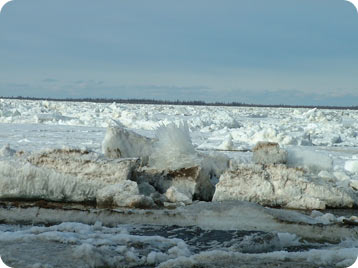When spring arrives above the Arctic Circle, great rivers in Russia, Canada, and Alaska roar to life. They carry melted snow and ice that accumulated during the long winter northward to the Arctic Ocean, providing sudden jolts of fresh water.
 Ice covered Lena River in Alaska. Credit: The Arctic Great Rivers Observatory, picture taken by R.M. Holmes.
Ice covered Lena River in Alaska. Credit: The Arctic Great Rivers Observatory, picture taken by R.M. Holmes. In fact, the Arctic Ocean receives about a tenth of all the fresh water that empties into the world’s oceans, even though it accounts for just one percent of the total volume of ocean water.
Countless individual rivers and streams empty into the Arctic Ocean. But most of the fresh water comes from just six major rivers. Four of them are in Russia, with two in North America: the Yukon in Alaska, and the Mackenzie in Canada’s Northwest Territories.
These rivers add some water to the Arctic Ocean all year long. During the winter, when ice covers both land and sea, it’s just a trickle. Yet that trickle contains a lot of nutrients, so it helps sustain life during the dark winter months, when there’s no sunlight to drive the growth of microscopic plants that are the first link in the ocean food chain.
Most of the river water enters the Arctic during the spring thaw, with each river providing its own unique mix of nutrients and sediments.
Over the last half-century, the Russian rivers have been adding a lot more water to the Arctic Ocean each year. And the spring thaws have been arriving earlier. These changes could have important impacts far beyond the Arctic Ocean. We’ll talk about that on our next program.
This episode of Science & the Sea was made possible by a grant from the National Science Foundation Office of Polar Programs.

